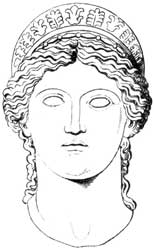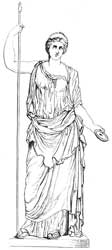Juno
The name of Juno is probably of the same root as Jupiter, and differs from it only in its termination. As Jupiter is the king of heaven and of the gods, so Juno is the queen of heaven, or the female Jupiter. The Romans identified at an early time their Juno with Hera, with whom she has indeed many resemblances, but we shall endeavor here to treat of the Roman Juno exclusively, and to separate the Greek notions entertained by the Romans, from those which are of a purely Italian or Roman nature.

Juno, as the queen of heaven, bore the surname of Regina, under which she was worshiped at Rome from early times, and at a later period her worship was solemnly transferred from Veii to Rome, where a sanctuary was dedicated to her on the Aventine.1 She is rarely described as hurling the thunderbolt, and the main feature of her character is, that she was to the female sex all that Jupiter was to the male, and that she was regarded as the protectress of every thing connected with marriage. She was, however, not only the protecting genius of the female sex in general, but accompanied every individual woman through life, from the moment of her birth to the end of her life. Hence she bore the special surnames of Virginalis and Matrona, as well as the general ones of Opigena and Sospita,2 under which she was worshiped both at Lanuvium and at Rome.3 On their birthday women offered sacrifices to Juno surnamed Natalis, just as men sacrificed to their genius natalis;4 but the general festival, which was celebrated by all the women, in honor of Juno, was called Matronalia,5 and took place on the 1st of March. Her protection of women, and especially her power of making them fruitful, is further alluded to in the festival Populifugia6 as well as in the surname of Februarius, Februata, Februta, or Februalis.7
Juno was further, like Saturn, the guardian of the finances, and under the name of Moneta she had a temple on the Capitoline hill, which contained the mint. 8 Some Romans considered Juno Moneta as identical with Mnemosyne, but this identification undoubtedly arose from the desire of finding the name Moneta a deeper meaning than it really contains. The most important period in a woman's life is that of her marriage, and, as we have already remarked, she was believed especially to preside over marriage. Hence she was called Juga or Jugalis, and had a variety of other names, alluding to the various occasions on which she was invoked by newly-married people, such as Domiduca, Interduca, Pronuba, Cinxia, Prema, Pertunda, Fluonia, and Lucina.9 The month of June, which is said to have originally been called Junonius, was considered to be the most favorable period for marrying.10

Juno, however, not only presided over the fertility of marriage, but also over its inviolable sanctity, and unchastity and inordinate love of sexual pleasures were hated by the goddess. Hence a law of Numa ordained that a prostitute should not touch the altar of Juno, and that if she had done so, she should with disheveled hair offer a female lamb to Juno11 Women in childbed invoked Juno Lucina to help them,12 and after the delivery of the child, a table was laid out for her in the house for a whole week,13 for newly-born children were likewise under her protection, whence she was sometimes confounded with the Greek Artemis or Eileithyia.14
As Juno has all the characteristics of her husband, in so far as they refer to the female sex, she presides over all human affairs, which are based upon justice and faithfulness, and more especially over the domestic affairs, in which women are more particularly concerned, though public affairs were not beyond her sphere, as we may infer from her surnames of Curiatia and Populonia. In Etruria, where the worship of Juno was very general, she bore the surname of Cupra, which is said to have been derived from the name of a town, but it may be connected with the Sabine word cyprus, which, according to Varro,15 signified good, and also occurs in the name of Vicus Cyprius. At Falerii, too, her worship was of great importance,16 and so also at Lanuvium, Aricia, Tibur, Praeneste, and other places.17
❧
Iconography
In the representations of the Roman Juno that have come down to us, the type of the Greek Hera is commonly adopted. She is portrayed as a dignified and majestic woman. Famous is the statue of Hera Ludovisi, a Roman copy of the Greek original from the fourth century, in which Goethe saw the ideal of feminine beauty and dignity. The Juno Barberini, a standing figure, at Rome is unusual because of the curious crease in the garment. See further iconography of Hera.
References
Notes
- Livy. The History of Rome v, 21, 22; xxii, 1; xxvii, 37; Varro. On the Latin Language v, 67.
- Ovid. Fasti vi, 33; Horace. Odes, iii, 4, 59; Servius on Virgil's Aeneid viii, 84; Augustine. City of God iv, 11; Festus, p. 343 (ed. Müller).
- Livy. The History of Rome xxiv, 10; xxvii, 3, xxxii, 30; Ovid. Fasti ii, 56; Cicero. De Divinatione i, 2.
- Tibullus, iv, 6; xiii, 15.
- Dictionary of Antiquities, s.v..
- ibid..
- Festus, s.v. Februarius, p. 85 (ed. Müller); comp. Ovid. Fasti ii, 441.
- Livy. The History of Rome vi, 20.
- Virgil. Aeneid iv, 166, 457, with Servius' note; Ovid. Heroides vi, 43; Augustine. City of God vi, 7, 11; vii, 3; Arnobius, iii, 7, 25; vi, 7, 25; Festus, s.v..
- Macrobius. Saturnalia i, 12; Ovid. Fasti vi, 56.
- Gellius. Noctes Atticae iv, 3.
- Plautus. Aulularia iv, 7, 11; Plutarch. Roman Questions, 77; Sextus Propertius. Elegies v, 1, 95; Arnobius, iii, 9, 21, 23.
- Tertullian. De Anima, 39.
- Catullus, xxxiv, 13; Dionysius of Halicarnassus, iv, 15.
- On the Latin Language v, 159.
- Dionysius, i, 21.
- Ovid. Fasti vi, 49, 59; Livy. The History of Rome v, 21; x, 2; Servius on Virgil's Aeneid vii, 739; Strabo. Geography v, p. 241.
Sources
- Leick, Gwendolyn. (1998). A Dictionary of Ancient Near Eastern Mythology. New York: Routledge.
- Smith, William. (1870). Dictionary of Greek and Roman Biography and Mythology. London: Taylor, Walton, and Maberly.
- Werner, Karel. (2005). A Popular Dictionary of Hinduism. Richmond: Curzon Press.
This article incorporates text from Dictionary of Greek and Roman Biography and Mythology (1870) by William Smith, which is in the public domain.